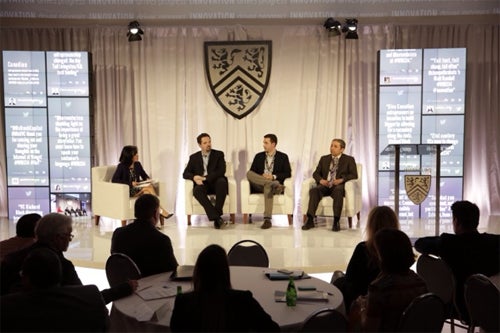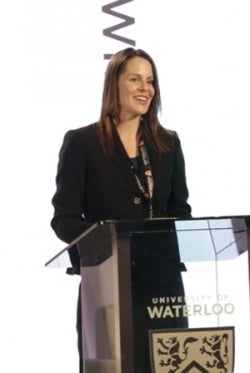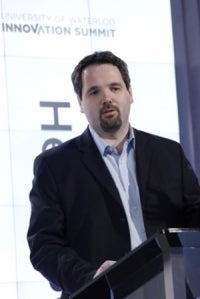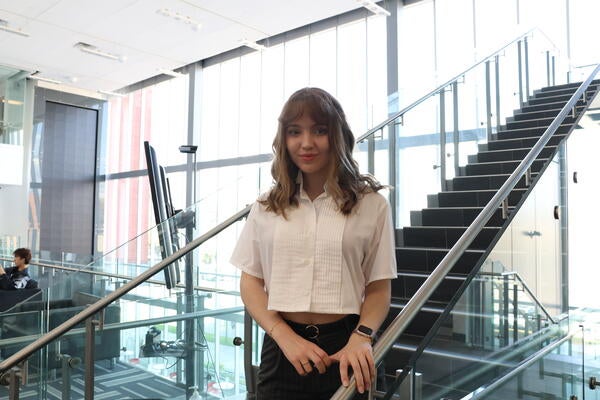
Innovation-rich region delivers lessons in success
Waterloo Innovation Summit brings together leading entrepreneurs, investors, academics, policymakers

Waterloo Innovation Summit brings together leading entrepreneurs, investors, academics, policymakers
By Bill Bean Marketing and Strategic CommunicationsReach for opportunities and don’t be afraid to take risks: It was a message that clearly resonated with the 200 audience members, speakers and panelists taking part in the first day of the 2014 Waterloo Innovation Summit.
The ability to combine technological creativity with business prowess was fundamental to messages delivered by presenters at the second annual gathering of entrepreneurs, investors, government officials, students and academics, taking place at the University of Waterloo on April 14 and 15.

Panel Discussion: Commercializing Innovation for Next-Generation Additive Manufacturing and Advanced Robotics with Pearl Sullivan, Helge Seetzen, Matt Rendall and Eshan Toyserkani
Matt Rendall, CEO of Clearpath Robotics, which just shipped its 1,000th robot, said that Canada is “globally competitive. We punch well above our weight class.
“We’re doing quite well, but we could be doing more.”
There were many suggestions about where else Canada could be punching above its weight class.
Venture capitalist Wal van Lierop pushed hard for the University’s students to consider careers in innovative clean technology. “Clean tech is becoming ready for prime time,” he said. He said the early market for clean tech was about $500 million, but suggested the future market could be up to $4 trillion. “We’ve have to kiss a lot of frogs, but now we are starting to find princes.”
Rendall told the audience he came to get them “jazzed about robotics,” saying advanced robotics is among the top dozen disruptive technologies of the next decade, with a $6 trillion potential. The audience laughed as he told of his company’s early robots (“Fail fast, fail cheap, fail often”), some of which are now a coffee table and a lamp at the corporate office.
He also told them of early support from the University of Waterloo, and how the university’s purchase of a robot, his company’s first sale, was parlayed into a successful business.
The first day of the summit featured a wide-ranging discussion of the future potential for additive manufacturing, advanced robotics, telecommunications, clean-tech innovation and internet-enabled consumer devices.

Whitney Rockley, co-founder of McRock Capital — a venture capital firm focused exclusively on the industrial internet — said that with only one per cent of things now connected to the internet, “the internet of things” presents a huge opportunity, which she estimated at $17 trillion. It’s a revolution she predicts will see objects linked online at an even greater rate than people.
In a world rich with opportunities, presenter after presenter reminded the audience that Canadians could play a major role in all of it.
University of Waterloo President Feridun Hamdullahpur captured the essence of the day in his opening remarks to the Waterloo Innovation Summit, by saying that in this region, “We are extremely good at more than one thing.”
Hamdullahpur said the Waterloo region economy is robust, with “a full spectrum of innovation” — from startup support to industry partners.
Gary Goodyear, Minister of State responsible for the Federal Economic Development Agency for Southern Ontario (FedDev Ontario), echoed the president, saying that Canada, and Waterloo Region are “a fertile landscape in which to do business.”
Business leaders of companies both large and small said that Canada has both an international reputation and an edge.
Tom Jenkins, chair of Open Text Corp., Canada’s largest software company, conceded that Canada is a small country — “Canada’s GDP is two per cent of the world’s GDP” — but told the audience that “Canada as a brand has done very well on a global stage.”
Speaking to the success of additive manufacturing was Ehsan Toyserkani, associate professor in the Department of Mechanical and Mechatronics Engineering and director of the Multi-scale Additive Manufacturing Laboratory at the University of Waterloo. He noted that the United States and China have committed up to $400 million each to additive manufacturing innovations, and pointed to developments as diverse as 3D-printed candy and superstrong aircraft parts as evidence of the ubiquity of the technology.
Certainly, the funds will be there. Haroon Mirza, entrepreneur in residence at OMERS Ventures, the venture capital investment arm of the OMERS pension plan, told the audience that OMERS has a $400 million fund to invest in Canadian companies. His advice to startup entrepreneurs: Find your narrative. Speak in the customers’ language. Be a thought leader.
 Venture capitalist Helge Seetzen said urged the students to consider careers in innovation technology: “Ideas are the currency of the 21st century, and innovation is the one way companies can differentiate themselves from everyone else.” He noted that Canada’s well-educated population of university students was a valuable resource: “Canada has a higher per capita percentage of this resource. Canada could be a leader in the innovation economy.”
Venture capitalist Helge Seetzen said urged the students to consider careers in innovation technology: “Ideas are the currency of the 21st century, and innovation is the one way companies can differentiate themselves from everyone else.” He noted that Canada’s well-educated population of university students was a valuable resource: “Canada has a higher per capita percentage of this resource. Canada could be a leader in the innovation economy.”

Read more
Fourth-year Global Business and Digital Arts student leverages artificial intelligence to fight food inflation, saving families up to $5,000 each year

Read more
Here are the people and events behind some of this year’s most compelling Waterloo stories

Read more
It Started in Waterloo: An Astronaut's Journey into the Universe of Innovation, narrated by Chris Hadfield, highlights the University of Waterloo’s role in igniting innovation within the region and beyond.
The University of Waterloo acknowledges that much of our work takes place on the traditional territory of the Neutral, Anishinaabeg, and Haudenosaunee peoples. Our main campus is situated on the Haldimand Tract, the land granted to the Six Nations that includes six miles on each side of the Grand River. Our active work toward reconciliation takes place across our campuses through research, learning, teaching, and community building, and is co-ordinated within the Office of Indigenous Relations.